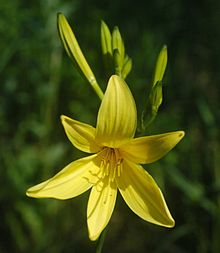Hemerocallis lilioasphodelus (syn. Hemerocallis flava, known as lemon daylily, lemon lily, yellow daylily, and other names) is a plant of the genus Hemerocallis. It is found in China, northeastern Italy, and Slovenia. It was also one of the first daylilies used for breeding new daylily cultivars.[1]
| Lemon daylily | |
|---|---|

| |
| Scientific classification | |
| Kingdom: | Plantae |
| Clade: | Tracheophytes |
| Clade: | Angiosperms |
| Clade: | Monocots |
| Order: | Asparagales |
| Family: | Asphodelaceae |
| Subfamily: | Hemerocallidoideae |
| Genus: | Hemerocallis |
| Species: | H. lilioasphodelus
|
| Binomial name | |
| Hemerocallis lilioasphodelus | |
Hemerocallis lilioasphodelus grows in big, spreading clumps, and its leaves grow to 75 cm (30 in) long. Its scapes each bear from 3 through 9 sweetly fragrant, lemon-yellow flowers.[1]
Culinary use
editThe flowers of some daylillies, including Hemerocallis lilioasphodelus are edible[2] and are used in Chinese and Japanese cuisine.
Gallery
edit-
Hemerocallis lilioasphodelus
-
Hemerocallis lilioasphodelus
-
Dried golden needles
-
Comparison showing flower in visible light, ultraviolet, and infrared. Note the nectar guide pattern visible in UV
-
Hemerocallis lilioasphodelus Stamen under the microscope. Magnification x9
References
editWikimedia Commons has media related to Hemerocallis lilioasphodelus.
- ^ a b Botanica : the illustrated A-Z of over 10,000 garden plants and how to cultivate them., Köln: Könemann, 2004, p. 440, ISBN 978-3-8331-1253-9
- ^ Niering, William A.; Olmstead, Nancy C. (1985) [1979]. The Audubon Society Field Guide to North American Wildflowers, Eastern Region. Knopf. p. 600. ISBN 0-394-50432-1.